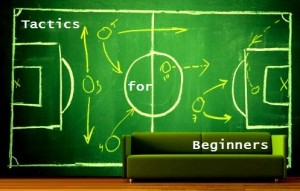By Bob Pearce and Mihail Vladimirov.
‘The space or the ball’
Last time we spoke about the importance of space, and you started by saying ‘in football everything gravitates around two basic but crucial concepts – what you do with the ball and what you do without the ball’. We talked about making space when you have the ball. Now maybe we can talk about denying space when you don’t have the ball. Presumably teams will defend differently depending on their style of play?
Generally, yes. Depending on their defensive strategy (proactive or reactive) they would have different ways of defending, either marking the space or marking the ball (i.e. the players that are on the ball).
To mark the space you are in essence focusing on limiting the space the opposition will have in your half. To do that you give up pressing them and instead choose to stand-off (usually in two banks of four, particularly if your opposition has a three-man midfield), simply crowding your defensive third and completely suffocating the opposition for space in that zone.
The proactive team will exert similar suffocation but in a different way and with a different aim. To mark the ball/the players that are on the ball is to deny the opposition time on the ball. They will try to press fiercely in order to put the opposition under massive pressure in order to either regain the ball or simply force them to retreat deeper and deeper (hence pushing them away from the team’s own “hot zone”). In order to do this you not only need to go and press fiercely, but you also need to ensure that you don’t give the opposition any sort of tactical advantage. For example pressing a three-man midfield with a two-man midfield (i.e. using 4-4-2 to press 4-2-3-1 or 4-1-2-3) is tactical suicide as you are immediately gifting your opposition a free way to just out-pass you through the middle in a 3 v 2. But if you have a three-man midfield too they don’t have this advantage, so you could go on and press them, and deny them time on the ball.
Is it too simple to say that defence is not a zone, it is a state, and it can take place in all zones. If you don’t have the ball you are defending, no matter where the ‘active space’ is on the pitch?
Yes, precisely. As soon your team loses the ball the player should switch from attacking to defensive mode. Again, depending on your defensive strategy (standing-off or pressing), the team could have a different defensive “active space”.
For the standing-off team – their brief will be to focus on defending their own “hot zone” (i.e. their defensive third), so as soon as they lose the ball they will aim to quickly drop back and occupy their pre-set defensive positions within their chosen defensive shape.
But for the pressing team it’s different. There are no such spaces as they would defend from all over the pitch as soon as they lose the ball, in order to regain it again as fast as possible.
So I could just watch a neutral game and focus on each team’s responses when they lose possession.
Yes, why not – this would be a good exercise for your eyes.
The rest of this post is for subscribers only.
[ttt-subscribe-article]
